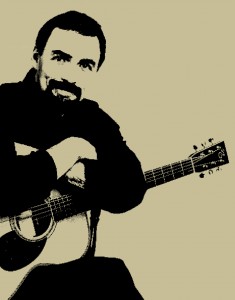Videos by American Songwriter
It’s virtually impossible to think about country music without thinking of guitars. The guitar is essentially the logo of country music. Even more so than in rock music, the guitar has been on every country record that’s ever been made. I’d be willing to bet that 95 percent of country songs have been written on the guitar as well. Guitars are inexpensive and portable. It’s relatively easy to learn a few chords and play thousands of songs with a minimum of time invested. When you learn to play it, it’s kind of like having somebody around to talk to. You just have to start the conversation, and know how to listen. It’s simple. Not necessarily easy, but simple.
Rather than go way back into the history of country music or the guitar, I’d like to talk about how country music has changed in the last 40 years or so. My dad played country music, and I’ve talked about how he and his buddies jammed in the living room on weekends. I was into rock and roll, but I still played along with “The Great Speckled Bird” and “Tennessee Waltz” (the Pee Wee King version). Throughout the ‘60s and ‘70s, I played mostly rock and pop music, but regularly listened to Chet Atkins records and stole tons of Lloyd Green’s steel guitar licks. Whenever Tennessee Ernie Ford came to Atlanta, he’d have the leader call me because I could read his charts and play bona fide country licks as well. I got a lot of mileage out of Chet and Lloyd and Grady Martin. Listen to Grady Martin’s acoustic fills on “El Paso” by Marty Robbins if you want to hear a master at work.
When Chips Moman got me to move to Nashville in 1981, I was not unfamiliar with the genre. Fortunately, I got to record with Willie, Waylon, Tammy Wynette, Billy Joe Royal and Webb Pierce the first year I was in town. After moving here, I got into songwriting and co-wrote some songs that got recorded by Keith Whitley and T.G. Shepard. I also played guitar on tons of songwriter demos. I’ve noticed some changes in country music since then.
There is some validity to the expression that country music is “three chords and the truth” as a general statement. Sure, Hank Williams, Hank Cochran and Harlan Howard wrote a lot of great songs using only three chords, but even in the ‘60s, you had Willie Nelson’s “Crazy,” a hit for Patsy Cline in 1962. “Crazy” has a whole passel of chords in it, due to Willie’s fondness for jazz, and for gypsy guitarist Django Reinhardt. If you looked at the country charts in 1962, you’d find that most of the songs did have only three or four chords. What were those chords? As usual, the 1, 4, and 5 chords are the most common. (If you’re in the key of G, that’s G, C, and D or D7.) What’s the fourth chord? Usually, a 2-seven chord leading to a 5-seven chord which leads back to the 1 chord. A7 to D7 back to G. “Your Cheating Heart” is the perfect example. Do any of the Mel Bay books tell you this? No.
Country swing music has more complex “jazzy” chords, with lots of 6ths, and lots of “secondary dominant” chords. If you’re in the key of G, try these chords: G, B7, E7, A7 D7 back to G. Listen to “San Antonio Rose” and google Bob Wills.
In the ‘70s a country-rock band from California changed everything. The Eagles played a lot of sus4, add9 and sus2 chords. In the ‘80s, these “color” chords started showing up everywhere on country records. Guess what else started showing up? “Connector” chords. For instance, G to D/F# to Em. In numbers, that’s 1 to 5/7 to 6m if we’re in G. Play along with “Hotel California” with your capo on the second fret. The intro/verse chords are Am, E/G# (not E), G, D/F# (not D) etc. So, as I’ve harped on before, learning your “color” chords and “connector” chords are important. If you listen to any country ballad recorded in the last thirty years, you might think you’re hearing the acoustic guitar in the intro or first verse playing G, C, and D chords. You’re not. Almost invariably, you’re hearing add9s, sus2 and sus4 chords. In 1998, Faith Hill recorded “This Kiss” written by Beth Nielsen Chapman, Annie Roboff, and Robin Lerner. Since then, the country charts have had a lot more non-traditional hits. “This Kiss” and many later recordings are very “pop,” while Jason Aldean’s records are very “rock.” The country genre has widened its boundaries considerably, much to the chagrin of some folks. As the boundaries widen, you hear more variety in chords, chord progressions, rhythms, guitar sounds, production values, and lyrics.
As for guitar sounds, things have tended to go in cycles. There was a time when you only heard Telecasters with lots of compression on country records. In the ‘80s, there was a period when the popular sound was a Strat through a chorus pedal (I really got sick of that one.) Now, it’s wide open, which I like. Brent Mason and Brad Paisley have killer “tele” sounds and you hear more humbucker-equipped guitars (like Gibsons) than you would have 10 or 15 years ago.
Some essential listening on country guitar sounds and techniques are Grady Martin on Marty Robbins’ “El Paso,” Roy Nichols on Merle Haggard’s “Mama Tried,” Ray Flacke on Ricky Skaggs’ “Highway Forty Blues,” Albert Lee on Rosanne Cash’s “My Baby Thinks He’s A Train,” Reggie Young on Haggard’s “That’s The Way Love Goes” and Vince Gill’s “Liza Jane.” And check out James Burton, Hank Garland, Jimmy Bryant, Steve Wariner, John Jorgensen, Chet, Jerry Reed, Merle Travis, Brent Rowan, Pete Huttlinger, and Tommy Emmanuel, Doyle Dykes. I could go forever.


2 Comments
Leave a Reply